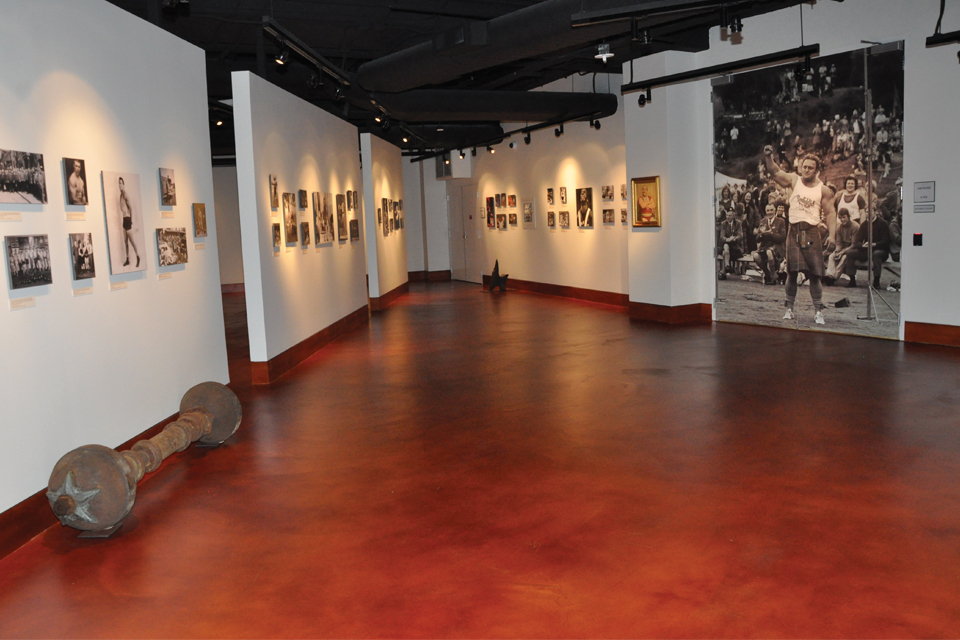The H.J. Lutcher Stark Center: A Collection of Sport and Culture

Years ago, toting around barbells was an act of rebellion. Lutcher Stark did so with flair—often hauling them around Austin in the back of his Rolls Royce.
Stark, who served as manager for the Texas Football team, was an only child from a prominently wealthy East Texas family, and, shortly after graduating from UT, he travelled to Philadelphia in 1913 looking for instruction. With the goal of trimming some body fat off his 200-pound, 5-foot-7 frame, Stark studied weight training under Alan Calvert.
It was a renegade move. At that time, it was universally believed by athletic trainers and sports physicians that resistance training would render a person clumsy, stiff, and generally hopelessly muscle bound. Yet, after studying and working with Calvert for two months, Stark returned to Texas some 40 pounds lighter, and a willing case study for a form of exercise that has revolutionized fitness in the century since.
Today, the H.J. Luther Stark Center exists on the UT campus as not just a fitting tribute to the visionary man from West Orange, Texas, but also as world-leading archive for collecting, displaying, and disseminating information and material concerning the history and role of physical culture and sports in society.
The Stark Center is co-directed by Terry and Jan Todd, a husband—wife team that also paved paths in competitive weightlifting. Jan, a powerlifter, was considered by the Guinness Book of Records in the 1970s and 80s as the “strongest woman in the world.” Terry was a 1950s tennis letterman with the Longhorns who also won intercollegiate championships in weightlifting.
“I looked very different from my (tennis) teammates,” Terry Todd said. “I weighed 245 and, at that time, only one football player even weighed that much. It just shows you how far we’ve come…At one point, weight lifting was forbidden. Now it’s required.”
That drastic shift in mindset can be traced back to Stark and his good friend and UT men’s athletics director Theo Bellmont. With the barbells Stark unloaded from his luxury cruiser, the two men often worked out together at the center of campus. Bellmont also presided over the Physical Education and Physical Training programs for all university students, and in 1919, UT hosted classes for the first heavyweight lifting class ever taught in the United States. The class was instructed by Roy McLean, who eventually mentored Todd during his time as a UT student.
“Because of his relationship with Bellmont and Stark, McLean could get the support and financial means to equip the campus weight room unlike any other in the country,” Todd said. “At one point, there were 15 Olympic lifting platforms.”
Todd worked in a rare books library on campus, learning an appreciation for the great care and reverence necessary in maintaing items of historical and intellectual value. He and his wife, Jan, began collecting materials about physical culture and sports before they arrived at UT in 1983 to join the Department of Kinesiology and Health Education in the College of Education. With an expansive collection of publications, photographs, art, artifacts, and other materials related to the history of sports, health, exercise, and other areas in the field known as “physical culture,” the Todds hoped to create a resource center for academic research on campus that would also honor the university’s historical role in shaping health and fitness through generations.
But the collection’s increasing size and stature soon outgrew the few office spaces the Todds were granted in the Gregory Gym, Anna Hiss Gym, and Bellmont Hall.
“We were filling up rooms with just our materials,” Todd recalled. “We were spilling out of boxes and rolling book carts.”
When the athletics department decided to expand Darrell K Royal-Texas Memorial Stadium in 2008 with a new north end zone, the Todds took that as an opportunity to find a fitting and per-manent home for the cultural archive. The only catch was raising the money to fund construction of the 27,500-square-foot facility. Joe and Betty Weider, along with the Stark Foundation, provided financial gifts and endowments that allowed the expansive museum space and research center to become a reality.
Weider himself was a Canadian weightlifter who started a publishing company in 1940 from his parents’ living room, and his publications eventually included the likes of Muscle Builder, Muscle & Fitness, and Shape, which launched in 1981 with Betty Weider’s direction.
The Stark Center’s Joe and Betty Weider Museum of Physical Culture hosts permanent and rotating exhibits detailing the history of physical fitness, weight training, and health promotion. In addition, the Weiders have donated more than 20 important pieces of art and other memorabilia from their personal collection, including three large oil paintings by the noted artist Thomas Beecham of Mr. Olympia winners Larry Scott, Franco Columbu, and Lee Haney.
“We understand it’s our responsibility to give these collections a good home,” Todd said.









